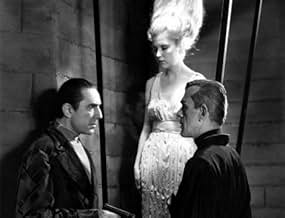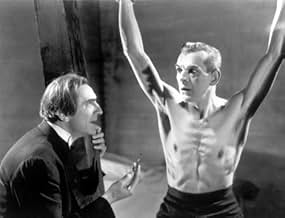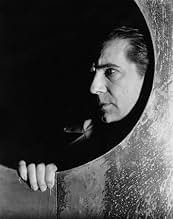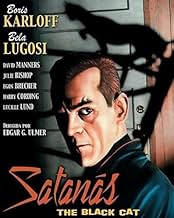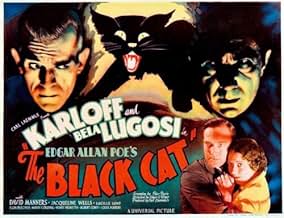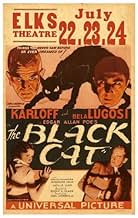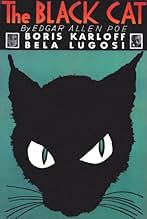IMDb-BEWERTUNG
6,9/10
13.947
IHRE BEWERTUNG
Ein amerikanisches Paar auf Hochzeitsreise in Ungarn wird im Haus eines satanistischen Priesters gefangengenommen, als die Braut nach einem Autounfall dort medizinisch versorgt werden soll.Ein amerikanisches Paar auf Hochzeitsreise in Ungarn wird im Haus eines satanistischen Priesters gefangengenommen, als die Braut nach einem Autounfall dort medizinisch versorgt werden soll.Ein amerikanisches Paar auf Hochzeitsreise in Ungarn wird im Haus eines satanistischen Priesters gefangengenommen, als die Braut nach einem Autounfall dort medizinisch versorgt werden soll.
- Auszeichnungen
- 2 Gewinne & 1 Nominierung insgesamt
Boris Karloff
- Hjalmar Poelzig
- (as Karloff)
Julie Bishop
- Joan Alison
- (as Jacqueline Wells)
Virginia Ainsworth
- Cultist
- (Nicht genannt)
Luis Alberni
- Train Steward
- (Nicht genannt)
King Baggot
- Cultist
- (Nicht genannt)
Herman Bing
- Car Steward
- (Nicht genannt)
Symona Boniface
- Cultist
- (Nicht genannt)
John Carradine
- Cult Organist
- (Nicht genannt)
André Cheron
- Train Conductor
- (Nicht genannt)
George Davis
- Bus driver
- (Nicht genannt)
Andy Devine
- Bit Part
- (Nicht genannt)
Empfohlene Bewertungen
Made in 1934 by the then 30 year old Director Edgar Ulmer and with the stunning set design by Charles D. Hall the film paired Boris Karloff and Bela Lugosi for the first time together on the screen. This was to cement the two icons together in a screen partnership that would last for several years.
Set in the modern house of Hjalmar Poelzig (no creepy old castle's here) whose home is one of the most stunning modern houses of our time this is a dark story about Devil worship. Poelzig has a room set aside for his evil black masses and has a penchant for the ladies, but only when they are being put to the devil's business. Into this walks a young couple who due to circumstances out of their control end up having to stay the night at his home. They arrive with Dr.Verdegast (Lugosi) who is returning after a absence of many years to settle some unfinished business with his old friend. This is the set up for an explosive encounter between the two into which the young honeymooning couple are thrown.
Truly a masterpiece it should be viewed over and over again.
Watch out for the finale Black Mass in which Karloff spout's authentic sounding incantation's to raise the Devil, he says Latin phrases "Cave Canium" (Beware of the Dog), "In Vito Veritas" (In Wine there if truth) and Cum Grano Salis (with a grain of salt). I could'nt put it better myself.
Set in the modern house of Hjalmar Poelzig (no creepy old castle's here) whose home is one of the most stunning modern houses of our time this is a dark story about Devil worship. Poelzig has a room set aside for his evil black masses and has a penchant for the ladies, but only when they are being put to the devil's business. Into this walks a young couple who due to circumstances out of their control end up having to stay the night at his home. They arrive with Dr.Verdegast (Lugosi) who is returning after a absence of many years to settle some unfinished business with his old friend. This is the set up for an explosive encounter between the two into which the young honeymooning couple are thrown.
Truly a masterpiece it should be viewed over and over again.
Watch out for the finale Black Mass in which Karloff spout's authentic sounding incantation's to raise the Devil, he says Latin phrases "Cave Canium" (Beware of the Dog), "In Vito Veritas" (In Wine there if truth) and Cum Grano Salis (with a grain of salt). I could'nt put it better myself.
THE BLACK CAT (1934) Starring Boris Karloff, Bela Lugosi, David Manners, Julie Bishop Directed by Edgar Ulmer
The first film to feature both Boris Karloff and Bela Lugosi, THE BLACK CAT was, and remains, innovative and strange. The opening credits claim the film was "suggested by" the Edgar Alan Poe story, but other than the title there is absolutely no connection.
Lugosi gets to play a good guy for a change and he handles it very well. In fact, I might venture to say that the role of Dr. Vitus Werdegast is Lugosi's finest performance, perhaps because it is so much of a departure from the role of Dracula. Karloff plays Hjalmar Poelzig, a Satanic architect with a really freaky hairdo. David Manners and Julie Bishop portray the Allisons, an American couple honeymooning in Hungary (doesn't everyone?).
The real star of this film, though, is the house. What an incredible set! The house, designed and built by Poelzig on the ruins of a WWI fort where thousands of soldiers are entombed, is an architectural marvel, even by today's standards. All glass and steel, the house consists of sharp angles that cast long, expressionistic shadows, which gives the film its extremely creepy atmosphere.
Werdegast (Lugosi) meets the Allisons on a train and later shares a cab with them. As they drive through a storm, he explains that he is going to visit an old friend after having spent 15 years as a prisoner of war. Not far from his friend's house the cab crashes, killing the driver and injuring Mrs. Allison. They carry her to Werdegast's friend's house. The friend, of course, is Poelzig (Karloff) and it soon becomes obvious that the term "friend" is applied very loosely. In fact, the men have become enemies due to the fact that Poelzig betrayed Werdegast during the war, which led to his long imprisonment. In the basement, Poelzig reunites Werdegast with his wife, now dead and whom Poelzig had married himself while Werdegast was in prison. The freaky architect has been keeping her preserved in some sort of suspended animation type thing. When Werdegast demands to know his daughter's whereabouts, Poelzig tells him that she, too, has died.
What follows is a bizarre tale of two men who are opposite sides of the coin. They engage in a chess match (literally and figuratively) with the soul of the injured Mrs. Allison up for grabs. THE BLACK CAT is incredibly creepy and has some real suspenseful moments. It also has some very disturbing scenes, especially for a film made in 1934. The scene of Karloff reciting the black mass in Latin is especially ominous. One cannot, however, help noticing some gaping holes in the plot. Dr. Werdegast is supposed to be Hungary's leading doctors, and yet he has just been released from 15 years of imprisonment. Huh? Also, there is a cruel scene where Lugosi's character kills a black cat (he has a phobia) and nobody seems to think anything about it...even though it appears to have been a pet in the household. These minor points do not take away from the overall viewing experience, though. THE BLACK CAT still looks great after all these years and it still has the ability to make you shudder.
The first film to feature both Boris Karloff and Bela Lugosi, THE BLACK CAT was, and remains, innovative and strange. The opening credits claim the film was "suggested by" the Edgar Alan Poe story, but other than the title there is absolutely no connection.
Lugosi gets to play a good guy for a change and he handles it very well. In fact, I might venture to say that the role of Dr. Vitus Werdegast is Lugosi's finest performance, perhaps because it is so much of a departure from the role of Dracula. Karloff plays Hjalmar Poelzig, a Satanic architect with a really freaky hairdo. David Manners and Julie Bishop portray the Allisons, an American couple honeymooning in Hungary (doesn't everyone?).
The real star of this film, though, is the house. What an incredible set! The house, designed and built by Poelzig on the ruins of a WWI fort where thousands of soldiers are entombed, is an architectural marvel, even by today's standards. All glass and steel, the house consists of sharp angles that cast long, expressionistic shadows, which gives the film its extremely creepy atmosphere.
Werdegast (Lugosi) meets the Allisons on a train and later shares a cab with them. As they drive through a storm, he explains that he is going to visit an old friend after having spent 15 years as a prisoner of war. Not far from his friend's house the cab crashes, killing the driver and injuring Mrs. Allison. They carry her to Werdegast's friend's house. The friend, of course, is Poelzig (Karloff) and it soon becomes obvious that the term "friend" is applied very loosely. In fact, the men have become enemies due to the fact that Poelzig betrayed Werdegast during the war, which led to his long imprisonment. In the basement, Poelzig reunites Werdegast with his wife, now dead and whom Poelzig had married himself while Werdegast was in prison. The freaky architect has been keeping her preserved in some sort of suspended animation type thing. When Werdegast demands to know his daughter's whereabouts, Poelzig tells him that she, too, has died.
What follows is a bizarre tale of two men who are opposite sides of the coin. They engage in a chess match (literally and figuratively) with the soul of the injured Mrs. Allison up for grabs. THE BLACK CAT is incredibly creepy and has some real suspenseful moments. It also has some very disturbing scenes, especially for a film made in 1934. The scene of Karloff reciting the black mass in Latin is especially ominous. One cannot, however, help noticing some gaping holes in the plot. Dr. Werdegast is supposed to be Hungary's leading doctors, and yet he has just been released from 15 years of imprisonment. Huh? Also, there is a cruel scene where Lugosi's character kills a black cat (he has a phobia) and nobody seems to think anything about it...even though it appears to have been a pet in the household. These minor points do not take away from the overall viewing experience, though. THE BLACK CAT still looks great after all these years and it still has the ability to make you shudder.
I won't comment about the acting or plot -- there's plenty of that here already. What I'd rather do is call attention to the visuals -- the cinematography, lighting, costuming, and especially the set design.
Normally, horror films take place in ancient settings -- crude medieval fortresses and rustic castles that are dark, cluttered and gloomy. But this one is set in a perversely utopian sci-fi fantasy -- the clean lined, impeccably detailed, generously glazed modernistic and (usually) radiantly lit white-and-silver upper floor interiors of the house.
The lower floor is an expressionistic prison, also clean lined, but still dungeon-like with its windowless walls of exposed board-formed concrete. An elegant steel spiral staircase connects the two, and the angular expressionism reaches its culmination in the chamber used for the black mass.
Karloff's costumes recall Oskar Schemmer's Bauhaus-produced work -- angular, broad-shouldered, narrow-waisted and elegant. Even the haircut of this man of the future in sharp and angular. His character is an engineer and architect and is given the name -- Poelzig -- of a famous expressionist German architect and film set designer of the time, who was a colleague of the director on an earlier film. The elegant futurism in carried down to the detail level, including a digital night-table clock and an abstract chess set. Much of the genius of this movie is that it breaks the horror-movie visual mold, and floods it with light, creating a fascinating tension between plot and setting.
Normally, horror films take place in ancient settings -- crude medieval fortresses and rustic castles that are dark, cluttered and gloomy. But this one is set in a perversely utopian sci-fi fantasy -- the clean lined, impeccably detailed, generously glazed modernistic and (usually) radiantly lit white-and-silver upper floor interiors of the house.
The lower floor is an expressionistic prison, also clean lined, but still dungeon-like with its windowless walls of exposed board-formed concrete. An elegant steel spiral staircase connects the two, and the angular expressionism reaches its culmination in the chamber used for the black mass.
Karloff's costumes recall Oskar Schemmer's Bauhaus-produced work -- angular, broad-shouldered, narrow-waisted and elegant. Even the haircut of this man of the future in sharp and angular. His character is an engineer and architect and is given the name -- Poelzig -- of a famous expressionist German architect and film set designer of the time, who was a colleague of the director on an earlier film. The elegant futurism in carried down to the detail level, including a digital night-table clock and an abstract chess set. Much of the genius of this movie is that it breaks the horror-movie visual mold, and floods it with light, creating a fascinating tension between plot and setting.
I can't imaging how this movie would have been without both Bela Lugosi and Boris Karloff, probably very very bad. The chemistry between the two is amazing.
This is one of those movies in which the story absolutely doesn't matter. The story is totally absurd and very simple (The black cat storyline has absolutely nothing to do with the movie and serves no purpose at all) but yet that is what maybe makes this movie extremely fun and easy to watch.
Watching this movie made me realize something; Bela Lugosi actually was a very good actor that was ahead of his time. The way he delivers his lines and his eye for details shows that acting was a great passion for him. Yes I think I can now be considered one of his fans.
Another great thing were the sets that were wonderful and even now 70 years later they still look very modern.
Don't expect a movie with ghouls and monsters, it rather is more fun to watch then it is scary and the Lugosi/Karloff combination is what makes this movie a real classic.
7/10
http://bobafett1138.blogspot.com/
This is one of those movies in which the story absolutely doesn't matter. The story is totally absurd and very simple (The black cat storyline has absolutely nothing to do with the movie and serves no purpose at all) but yet that is what maybe makes this movie extremely fun and easy to watch.
Watching this movie made me realize something; Bela Lugosi actually was a very good actor that was ahead of his time. The way he delivers his lines and his eye for details shows that acting was a great passion for him. Yes I think I can now be considered one of his fans.
Another great thing were the sets that were wonderful and even now 70 years later they still look very modern.
Don't expect a movie with ghouls and monsters, it rather is more fun to watch then it is scary and the Lugosi/Karloff combination is what makes this movie a real classic.
7/10
http://bobafett1138.blogspot.com/
"The Black Cat" (Universal, 1934), directed by Edgar G. Ulmer, marks the first scream, or should I say, screen teaming of Boris ("Frankenstein") Karloff, billed in the credits only as KARLOFF, and Bela ("Dracula") Lugosi.
Suggested on the immortal story by Edgar Allan Poe, the plot, compliments of screenwriter Paul Ruric, set in Hungary, gets right down to business with Doctor Vitus Werdegast (Bela Lugosi) returning home by train after serving 15 long years in a military prison. He finds himself sharing a compartment with mystery writer Peter Allison (David Manners) and his wife, Joan (Jacqueline Wells), on their honeymoon. Vitus introduces himself to the Allisons, talks about himself and of his mission to visit a "very old friend." The couple later accompany Werdegast on a bus to their destination, which meets with an accident during a rainstorm, killing the driver. Vitus accompanies Peter by taking the injured Joan through the rain and winds until they reach the home of Hjalmar Poelzig (KARLOFF), an architect of his futuristic mansion. As Vitus treats the unconscious Joan, Hjalmar, who makes his grand entrance, immediately takes notice on the young girl with intentions that are not too honorable. As the story progresses, the viewer learns that Vitus had been betrayed by Hjalmar during the World War and left to die at a military prison, and for this, Vitus, who survived those long dark years, returns to seek revenge, but first must learn what has happened to his wife and daughter. Peter and Joan become house guests in the home of Poelzig, unaware that they are his prisoners, with Poelzig, who holds Black Masses in a devil's cult ceremony, intending on using Joan as his next subject and hold Peter in a dungeon below. Besides trying to learn the whereabouts of his wife and daughter, Vitus tries to set Joan free by playing a game of chess, or a "game of death," with Hjalmar. Tension builds up to a very suspenseful climax not to be missed.
What does this have to do with a black cat? Well, Vitus fears cats and finds himself being confronted with one in two separate scenes, compliments of Hjalmar, who has cats roaming about. Karloff and Lugosi are evenly matched here, and as bitter enemies, they must present themselves in a "gentlemanly manner" whenever confronted by the young guest or guests. Also presented in the cast are Lucille Lund as Karen Poelzig; the evil looking Harry Cording as Thalmar, Hjalmar's servant; and John Carradine as one of the members of the cult during the Black Mass sequence.
Although produced in Hollywood, "The Black Cat" looks very much like a European production with futuristic sets which features a digital clock, etc. Karloff, dressed in black garments with a feline haircut, is very creepy, especially using gestures with his evil eyes (which do everything but glow in the dark!); Lugosi, in a rare sympathetic role, is actually the stronger character, giving one of his best performances in his career, next to "Dracula" (1931). Fortunately, "The Black Cat" was released shortly before the Production Code took effect, otherwise the horror drama, with many scenes quite questionable then and now, would never have reached the theaters unless severely edited to a point of confusion. Chances are the movie itself was edited prior to release, but at 66 minutes, it's tight and fast-paced, never a dull moment. A big plus in this production is the underscoring montage of classical compositions by various composers, lavish sets and the teaming of two horror greats, Karloff and Lugosi.
Aside from Fright Nights on commercial television back in the 1960s and 70s, "The Black Cat" formerly played on the Sci-Fi Channel in the 1990s, and later on American Movie Classics from 2000 to 2001. To date, "The Black Cat" can be seen on Turner Classic Movies where it premiered on January 24, 2003, becoming one of this cable channel's most revived horror films. Probably by request. "The Black Cat" is also available on video cassette either as part of the double feature along with "The Raven" (1935), another Karloff and Lugosi thriller, or as a solo package. A gem for fans of this genre. (***)
Suggested on the immortal story by Edgar Allan Poe, the plot, compliments of screenwriter Paul Ruric, set in Hungary, gets right down to business with Doctor Vitus Werdegast (Bela Lugosi) returning home by train after serving 15 long years in a military prison. He finds himself sharing a compartment with mystery writer Peter Allison (David Manners) and his wife, Joan (Jacqueline Wells), on their honeymoon. Vitus introduces himself to the Allisons, talks about himself and of his mission to visit a "very old friend." The couple later accompany Werdegast on a bus to their destination, which meets with an accident during a rainstorm, killing the driver. Vitus accompanies Peter by taking the injured Joan through the rain and winds until they reach the home of Hjalmar Poelzig (KARLOFF), an architect of his futuristic mansion. As Vitus treats the unconscious Joan, Hjalmar, who makes his grand entrance, immediately takes notice on the young girl with intentions that are not too honorable. As the story progresses, the viewer learns that Vitus had been betrayed by Hjalmar during the World War and left to die at a military prison, and for this, Vitus, who survived those long dark years, returns to seek revenge, but first must learn what has happened to his wife and daughter. Peter and Joan become house guests in the home of Poelzig, unaware that they are his prisoners, with Poelzig, who holds Black Masses in a devil's cult ceremony, intending on using Joan as his next subject and hold Peter in a dungeon below. Besides trying to learn the whereabouts of his wife and daughter, Vitus tries to set Joan free by playing a game of chess, or a "game of death," with Hjalmar. Tension builds up to a very suspenseful climax not to be missed.
What does this have to do with a black cat? Well, Vitus fears cats and finds himself being confronted with one in two separate scenes, compliments of Hjalmar, who has cats roaming about. Karloff and Lugosi are evenly matched here, and as bitter enemies, they must present themselves in a "gentlemanly manner" whenever confronted by the young guest or guests. Also presented in the cast are Lucille Lund as Karen Poelzig; the evil looking Harry Cording as Thalmar, Hjalmar's servant; and John Carradine as one of the members of the cult during the Black Mass sequence.
Although produced in Hollywood, "The Black Cat" looks very much like a European production with futuristic sets which features a digital clock, etc. Karloff, dressed in black garments with a feline haircut, is very creepy, especially using gestures with his evil eyes (which do everything but glow in the dark!); Lugosi, in a rare sympathetic role, is actually the stronger character, giving one of his best performances in his career, next to "Dracula" (1931). Fortunately, "The Black Cat" was released shortly before the Production Code took effect, otherwise the horror drama, with many scenes quite questionable then and now, would never have reached the theaters unless severely edited to a point of confusion. Chances are the movie itself was edited prior to release, but at 66 minutes, it's tight and fast-paced, never a dull moment. A big plus in this production is the underscoring montage of classical compositions by various composers, lavish sets and the teaming of two horror greats, Karloff and Lugosi.
Aside from Fright Nights on commercial television back in the 1960s and 70s, "The Black Cat" formerly played on the Sci-Fi Channel in the 1990s, and later on American Movie Classics from 2000 to 2001. To date, "The Black Cat" can be seen on Turner Classic Movies where it premiered on January 24, 2003, becoming one of this cable channel's most revived horror films. Probably by request. "The Black Cat" is also available on video cassette either as part of the double feature along with "The Raven" (1935), another Karloff and Lugosi thriller, or as a solo package. A gem for fans of this genre. (***)
Wusstest du schon
- WissenswertesAmong the unconventional elements of this film was the soundtrack. At a time (early 1930s) when movie music was usually limited to the titles and credits, Edgar G. Ulmer had an almost continuous background score throughout the entire film, culled nearly entirely from what sound's like a Reader's Digest collection of Best Beloved Classical Favorites, hardly an original note. A "Composer" for the film score is rightfully uncredited.
- PatzerVitus identifies Kurgaal as being "near Omsk, by Lake Baikal." In reality Omsk and Lake Baikal are approximately 1000 miles apart and are nowhere near each other.
- Zitate
Hjalmar Poelzig: Did you hear that, Vitus? The phone is dead. Even the phone is dead.
- VerbindungenEdited from Rom Express (1932)
Top-Auswahl
Melde dich zum Bewerten an und greife auf die Watchlist für personalisierte Empfehlungen zu.
Details
- Erscheinungsdatum
- Herkunftsland
- Sprachen
- Auch bekannt als
- El gato negro
- Drehorte
- Produktionsfirma
- Weitere beteiligte Unternehmen bei IMDbPro anzeigen
Box Office
- Budget
- 95.745 $ (geschätzt)
- Weltweiter Bruttoertrag
- 180 $
- Laufzeit
- 1 Std. 5 Min.(65 min)
- Farbe
- Seitenverhältnis
- 1.37 : 1
Zu dieser Seite beitragen
Bearbeitung vorschlagen oder fehlenden Inhalt hinzufügen


